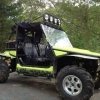Balljoints
-
Similar Topics
-
By aefron88
This post will explain how to hook up your PC to the ECU of a Hisun/Coleman/Etc UTV to be able to read error codes & engine parameters for troubleshooting purposes.
This is applicable to all small engines using the Delphi MT-05 ECU. This should cover all fuel injected Hisun models, as well as various other Chinese FI engines, as the Delphi MT-05 ECU seems to be the favored ECU solution.
Even though we get actual engine error codes to display on the dash, sometimes we have “pending codes” (not yet confirmed by the ECU) or other intermittent issues that are hard to diagnose, for example a poorly connected sensor that may give intermittent false readings, or a sensor that’s putting out bad date, but not bad enough for the ECU to realize.
The setup requires 2 cables, which are available for around $25 combined, a PC with a USB port, and some charityware software called “HUD ECU Hacker”. This gives the same functionality as the $300 dealer code scanner for a fraction of the price.
In searching I found info about HUD ECU Hacker, but I have yet to see info anywhere about how to hook it up to a Hisun, so I took the leap and bought some cables, and made it work. I will show a step by step of how to do so in post two.
I will be breaking this down into 2 posts:
Delphi ECU Info & Overview (This post) System setup & use Delphi ECU Info (Skip ahead to the next post if your eyes glaze over technical details)
The Delphi MT-05 ECU was developed to allow small engines to use fuel injection. A fuel injection system requires feedback from various sensors to operate efficiently. This feedback allows the adjustment of ignition timing, fuel injection volume, etc to efficiently and cleanly produce the most power possible from a given engine.
The MT-05 ECU has a number of sensors that are required for proper functioning including; Coolant temp, crankshaft position, intake temp, intake pressure, exhaust O2, throttle position, as well as some other optional sensors that are used on more complex vehicles.
From the sensors the ECU adjusts: Fuel injector timing/pulse, Idle air control valve, and ignition coil
The Delphi MT-05 puts out diagnostic data, however it is not ODB2 like a modern car, where is where it gets tricky reading it. There are three options, there is an old 16 bit piece of software Delphi has that is not able to run on a modern computer, there is the motorscanner tool for dealers ($300), or there is freeware HUD ECU Hacker with the proper cables.
-
By Grant
I recently bought an axis 500 and it’s missing a box or something the plug is L shaped I’ve looked through the wiring diagrams and still can’t figure it out. The plug is located right near the battery housing
-
By CYJSP2009
Dear Friends,
2022 Brand new Joyner CV Axles and CV Joint rebuild kits are comming
1. S650.03.02.02.00 ---Joyner 650 Commando Rear
2. TR1100.03.01.03.00 --- Joyner Trooper Front
3. TR1100.03.02.03.00 --- Joyner Trooper Rear
4. D650.03.02.02.00 --- Joyner 650 Sand Spider Rear Left
5. D650.03.02.03.00--- Joyner 650 Sand Spider Rear Right
6. SV800.03.02.01.00 --- Joyner 800 Viper, SV1100 Drive shaft Left
7. 14274 --- 650 ider rear left, rear right, 800 MV; 800Viper, SV1100 Drive shaft rear left and rear right outer cv joint rebuild kit
8. 15803 --- 650 Sand Spider rear left, rear right, 800 MV; 800Viper, SV1100 Drive shaft rear left and rear right outer cv joint rebuild kit
Attached are the part photos for reference.
Above parts are now on the way to USA, will be ready for inland delivery in middle of July.
Price: CV Axle: USD250/ Piece; CV Joint kit (without grease): USD110 send to door.
There will be special discount availabe for deals completed within July 2022.
Buy 1 piece: Get 5% discount,
Buy 2 pieces: get 10% discount.
Buy 3 pieces: get 15% discount,
Buy 4 and more than 4 pieces: get 20% discount.
Please kindly note Qty for each part is not big and it is hard to forcast when there will be next offer for these kind of products unless there is sufficient confirmed order qty for productioin arrangement.
Payment method: Payoneer payment link ( can pay through bank account or credit card) or Paypal ( [email protected]) . Payment commission paid by the buyer.
Interested parties, please contact [email protected].
Thanks
Good Luck
Casey / Leaf Asia
July-07-2022
-
By lincolnsq175
Ive searched and cannot find any performance parts that fit my machine.
I have a 2020 coleman ut400.
Im looking for machined sheave kit, programmers, cdi, exhaust and intake.
I know these are yamaha rhino clones but are they rhino 450 clones?
Any info is appreciated.
-
-
By Greg Kilgore
Got a 2021 Axis 500.
I'm needing the head bolt torque specs.
Manual states 38nm.
But saw a video Hisun put out on YT for a 550 stating 50nm + 45° turn of wrench. Didn't think they would be that much difference on a 500 and a 550.
Seen another YT video on a 2013 500. He did 38nm.
Really only want to do this job once and done. And done correct.
Anybody got the answer?
Going to start this rebuild in a few once this weather brakes. Flooding and then snow and cold here now. But spring is around the corner and the wife has to have this fixed or a Honda pioneer may be parked in driveway soon. She has to be able to ride.
-








Recommended Posts
Join the conversation
You can post now and register later. If you have an account, sign in now to post with your account.
Note: Your post will require moderator approval before it will be visible.